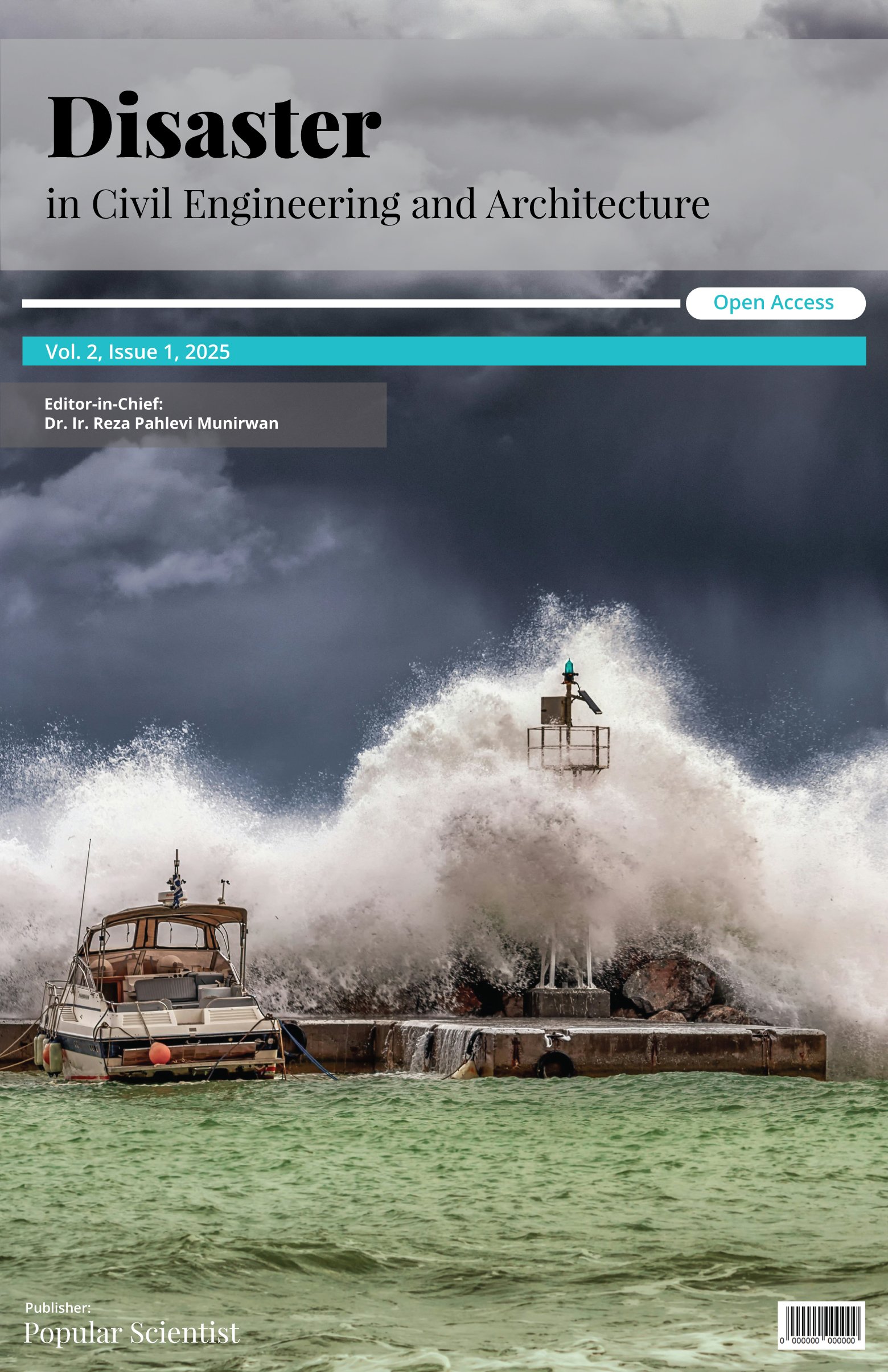Enhancing Urban Resilience: Mapping School Community Preparedness for Tsunami Disasters in Coastal Banda Aceh
DOI:
https://doi.org/10.70028/dcea.v1i2.30Keywords:
Banda Aceh, LIPI-UNESCO/ISDR, Urban Resilience, Disaster Preparedness, Tsunami Risk, School CommunityAbstract
Urban resilience against tsunami risks requires robust preparedness within educational institutions, particularly in high-risk coastal regions. This study assesses the disaster preparedness levels of senior high schools in the coastal districts of Meuraxa and Kuta Raja, Banda Aceh, employing a comprehensive mapping approach (LIPI-UNESCO/ISDR) to evaluate knowledge, preparedness policy, emergency planning, warning systems, and resource mobilization. Data were collected through questionnaires targeting school administrators, teachers, and students. The findings reveal significant disparities in preparedness levels, with SMAN 6 Banda Aceh demonstrating higher readiness compared to SMAS Al-Misbah, which exhibited the lowest scores across all dimensions. The absence of standardized disaster management policies and inadequate institutional preparedness were identified as critical challenges. The study underscores the urgent need for integrated disaster education, routine evacuation drills, and well-coordinated emergency response strategies to enhance school and community resilience. Furthermore, it advocates for a collaborative approach involving local authorities, educators, and disaster management agencies to embed disaster preparedness into the urban resilience framework. By mapping preparedness levels, this research provides actionable insights for policymakers to develop targeted interventions and promote sustainable disaster resilience strategies. Future research should expand to other vulnerable coastal areas and assess the long-term impacts of preparedness initiatives to ensure effective risk reduction.
Downloads
References
Badan Nasional Penanggulangan Bencana (BNPB), “Potensi Ancaman Bencana,” 2015. [Online]. Available: https://www.bnpb.go.id/potensi-ancaman-bencana.
Syamsidik, A. Nugroho, R. S. Oktari, and M. Fahmi, Aceh Pasca 15 Tahun Tsunami: Kilas Balik dan Proses Pemulihan. Banda Aceh: TDMRC USK, 2019.
M. Haiqal, L. H. Sari, E. Zuraidi, and P. Hasibuan, “A review of vertical evacuation on tsunami mitigation case,” IOP Conf. Ser.: Mater. Sci. Eng., vol. 523, no. 1, 2019, doi: http://dx.doi.org/10.1088/1757-899X/523/1/012061
H. Cao, “Urban resilience: Concept, influencing factors and improvement,” Frontiers Bus. Econ. Manag., vol. 9, no. 1, 2023.
Q. Fu and X. Zhang, “Promoting community resilience through disaster education: Review of community-based interventions with a focus on teacher resilience and well-being,” PLoS ONE, vol. 19, no. 1, pp. 1–22, Jan. 2024, doi: http://dx.doi.org/10.1371/journal.pone.0296393
S. Meerow, J. P. Newell, and M. Stults, “Defining urban resilience: A review,” Landscape Urban Plan., vol. 147, pp. 38–49, 2016, doi: http://dx.doi.org/10.1016/j.landurbplan.2015.11.011
M. Pelling, “Urban governance and disaster risk reduction in the Caribbean: The experiences of Oxfam GB,” Environ. Urban., vol. 23, no. 2, pp. 383–400, 2011, doi: http://dx.doi.org/10.1177/0956247811410012
E. Zuraidi, I. Caisarina, and Z. Fuady, “The Islamic public space concept in the Southeast Asia region as a friendly urban design and planning enlightening,” IOP Conf. Ser.: Earth Environ. Sci., vol. 452, no. 1, 2020, doi: http://dx.doi.org/10.1088/1755-1315/452/1/012146
E. Zuraidi, I. Caisarina, and M. Agustina, “A bibliometric study of global trends in community resilience and spatial planning research (2000-2021),” IOP Conf. Ser.: Earth Environ. Sci., vol. 881, no. 1, 2021, doi: http://dx.doi.org/10.1088/1755-1315/881/1/012067
E. Zuraidi, R. B. Zainol, Y. B. Ahmad, and A. Achmad, “Understanding the evolution and global trends of resilience and urban planning studies: A bibliometric analysis,” Planning Malaysia, vol. 20, no. 4, pp. 260–271, 2022, doi: http://dx.doi.org/10.21837/pm.v20i24.1203
E. Zuraidi, R. B. Zainol, Y. B. Ahmad, and A. Achmad, “Determinants of spatial planning for urban resilience in the Islamic society setting: A case study of Banda Aceh, Indonesia,” Planning Malaysia, vol. 21, no. 5, pp. 222–236, 2023, doi: http://dx.doi.org/10.21837/pm.v21i29.1367
United Nations International Strategy for Disaster Reduction (UNISDR), How to Make Cities More Resilient: A Handbook for Local Government Leaders. UNISDR, 2015.
V. K. Nakum et al., “Developing a framework on school resilience for risk-informed decision-making,” Prog. Disaster Sci., vol. 15, Art. no. 100237, 2022, doi: http://dx.doi.org/10.1016/j.pdisas.2022.100237
A. M. Ikramullah, E. Maryani, and I. Setiawan, “Fostering disaster preparedness school as an effort to build disaster preparedness,” IOP Conf. Ser.: Earth Environ. Sci., vol. 683, no. 1, 2021, doi: http://dx.doi.org/10.1088/1755-1315/683/1/012070
UNESCO, Kajian kesiapsiagaan masyarakat dalam mengantisipasi bencana gempa bumi dan tsunami di Nias Selatan. Jakarta: UNESCO Office Jakarta, 2007.
M. N. C. Pujianingsih et al., “Analisis kesiapsiagaan komunitas sekolah Muhammadiyah dalam menghadapi bencana tanah longsor di Kabupaten Karanganyar,” J. Geogr. Edukasi Lingkung., vol. 3, no. 2, pp. 100–107, 2019.
D. Hidayati et al., Kajian Kesiapsiagaan Masyarakat dalam Mengantisipasi Bencana Gempa Bumi & Tsunami. Jakarta: LIPI-UNESCO, 2006.
S. L. Cutter et al., “A place-based model for understanding community resilience to natural disasters,” Global Environ. Change, vol. 18, pp. 598–606, 2008, doi: http://dx.doi.org/10.1016/j.gloenvcha.2008.07.013
D. Paton and D. Johnston, “Disasters and communities: vulnerability, resilience and preparedness,” Disaster Prev. Manag., vol. 10, no. 4, pp. 270–277, 2001, doi: http://dx.doi.org/10.1108/EUM0000000005930
R. Shaw, A. Sakurai, and Y. Oikawa, “New realization of disaster risk reduction education in the context of a global pandemic: Lessons from Japan,” Int. J. Disaster Risk Sci., vol. 12, no. 4, pp. 568–580, 2021, doi: http://dx.doi.org/10.1007/s13753-021-00337-7
J. Ahern, “From fail-safe to safe-to-fail: Sustainability and resilience in the new urban world,” Landscape Urban Plan., vol. 100, no. 4, pp. 341–343, 2011, doi: http://dx.doi.org/10.1016/j.landurbplan.2011.02.021
V. A. Johnson, K. R. Ronan, D. M. Johnston, and R. Peace, “Implementing disaster preparedness education in New Zealand primary schools,” Disaster Prev. Manag., vol. 23, no. 4, pp. 370–380, 2014, doi: http://dx.doi.org/10.1108/DPM-09-2013-0151
D. Coppola, G. D. Haddow, and J. A. Bullock, Introduction to Emergency Management, 5th ed. Butterworth Heinemann, 2013.
Federal Emergency Management Agency (FEMA), Developing and Maintaining Emergency Operations Plans: Comprehensive Preparedness Guide (CPG) 101, Version 2.0. Washington, DC: US Department of Homeland Security, 2010. [Online].
UNDRR, “The importance of early warning systems in disaster risk reduction,” Prevention Web, 2022. [Online].
P. A. Catalan et al., “Design and operational implementation of the integrated tsunami forecast and warning system in Chile (SIPAT),” Coastal Eng. J., vol. 62, no. 3, pp. 373–388, 2020, doi: http://dx.doi.org/10.1080/21664250.2020.1727402
N. Kapucu, “Culture of preparedness: Household disaster preparedness,” Disaster Prev. Manag., vol. 17, no. 4, pp. 526–535, 2008, doi: http://dx.doi.org/10.1108/09653560810901773
N. Brooks and W. N. Adger, “Assessing and Enhancing Adaptive Capacity,” in Technical Paper 7, 2023, pp. 165–181, doi: http://dx.doi.org/10.4337/9781788974912.A.8
Downloads
Published
Issue
Section
License
Copyright (c) 2025 Muhammad Riza Rizky, Evalina Zuraidi, Fahmi Aulia (Author)

This work is licensed under a Creative Commons Attribution-NonCommercial 4.0 International License.













